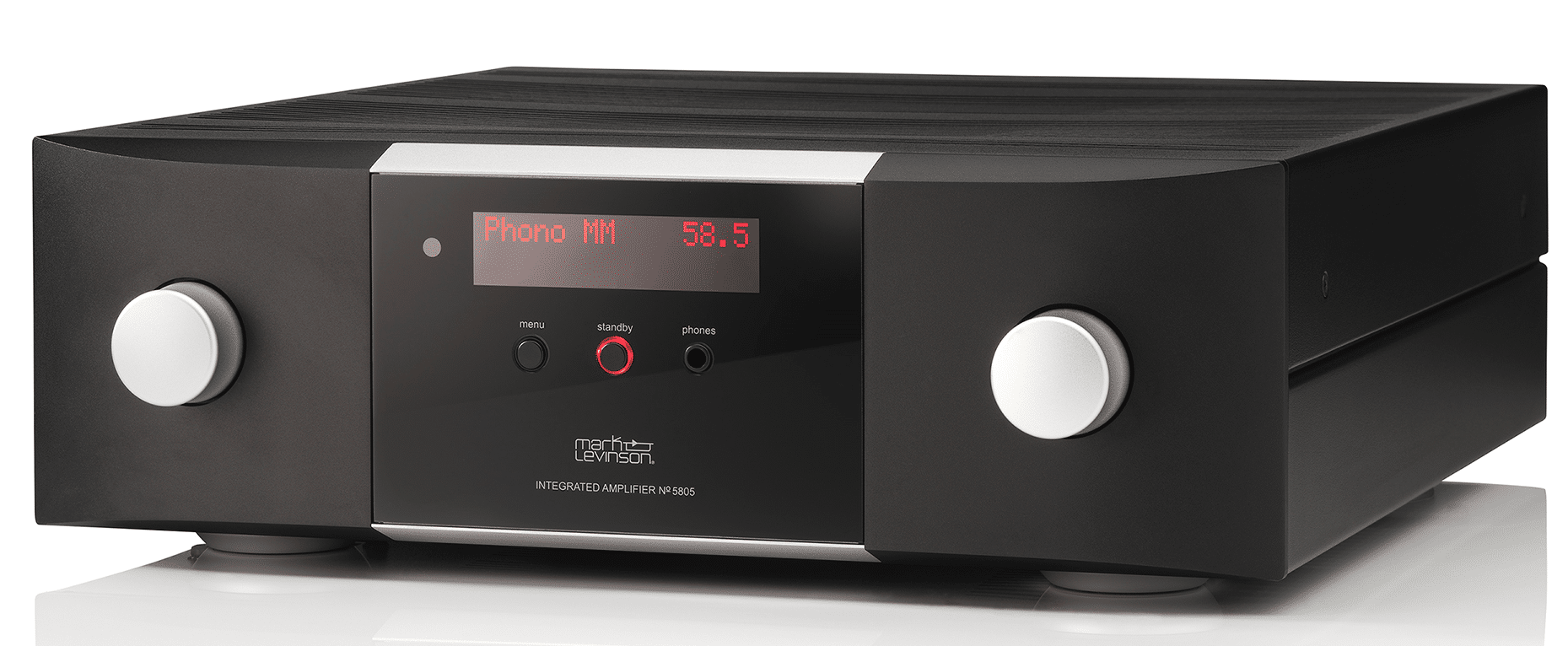Overview
In the following, we will first look at the 5805, as it is the more flexible model in terms of connection options, and then we will highlight the unique features of the 5802. Basically, both models are based on the same concept and have a lot in common. So we start with the case design, which immediately and identifies the amplifier as a Mark Levinson product and at the same time sets itself apart from the well-known models. The body is much slimmer and offers an interesting contrast to the other components, which tend to look rather bulky.
Furthermore, the front has also changed, which now has a kind of insert in the middle. There is the display with the red, roughly resolved segment display, the menu button, a headphone input (the headphone amplifier works in Class A mode by the way) and the standby switch. To the left and right of it, embedded in the all-aluminum front panel, the haptically excellent potentiometers for source selection and volume have been placed. Speaking of controls: A full aluminum remote control is of course included, but there is also the possibility to configure 5802 and 5805 via the computer, or more precisely the web browser – for this purpose there is an Ethernet socket on the back.
In terms of functionality, the 5805 offers a wide range of possibilities in excellent quality. First of all, there is the high-quality phono stage, which is suitable for both moving coil (MC) and moving magnet systems, is equipped with an optionally activatable subsonic filter and has a matrix for setting capacity and resistance for the respective pickup system used. Also, the preamplifier consists of three analog inputs – one of which is balanced in XLR format – and the digital section. This is where the so-called Mark Levinson Precision Link II DAC works, combining a 32-bit ESS Sabre D/A converter with state-of-the-art filter and jitter correction technology. In the case of the 5805, access to the sophisticated converter architecture is gained via a total of four inputs: USB (type B, asynchronous), 2x optical and 1x coaxial. Depending on the selected input, resolutions of up to 192 kHz / 32 Bit (PCM) or 5.6 MHz (DSD) can be reproduced. The menu also offers a variety of filter characteristics that subtly shape the sound – seven for PCM signals and four for DSD signals. Last but not least, a license for the special high-resolution format MQA (Master Quality Authenticated) was purchased so that titles encoded accordingly can be decoded without any problems.
At this point it is a good idea to hook in and talk briefly about the 5802: The main difference between the 5805 and the 5802 is that all analog inputs have been removed in favour of additional digital interfaces – here there is also a second coaxial input and an AES/EBU-XLR socket, and an aptX-HD-capable Bluetooth module has also been integrated.
In the power amplifier section, both model variants are finally the same again. We are dealing here with a strictly separate double mono construction, a substantial toroidal transformer with independent secondary windings for each channel elevated at the head end of the amplifier. The power transistors operate in efficient Class AB mode, delivering a full 125 watts at 8 and 250 watts at 4 ohms, respectively, and should, therefore, provide sufficient power in pretty much all audiophile situations. Nevertheless, there are still two line outputs available to pick up the preamp signal and send it to another power amplifier.
Final Thoughts
With the two models of the 5000 series Mark Levinson brings two extremely performant integrated amplifiers into position, which become even more impressive due to the lower price. We are already looking forward to testing the devices extensively on site.



